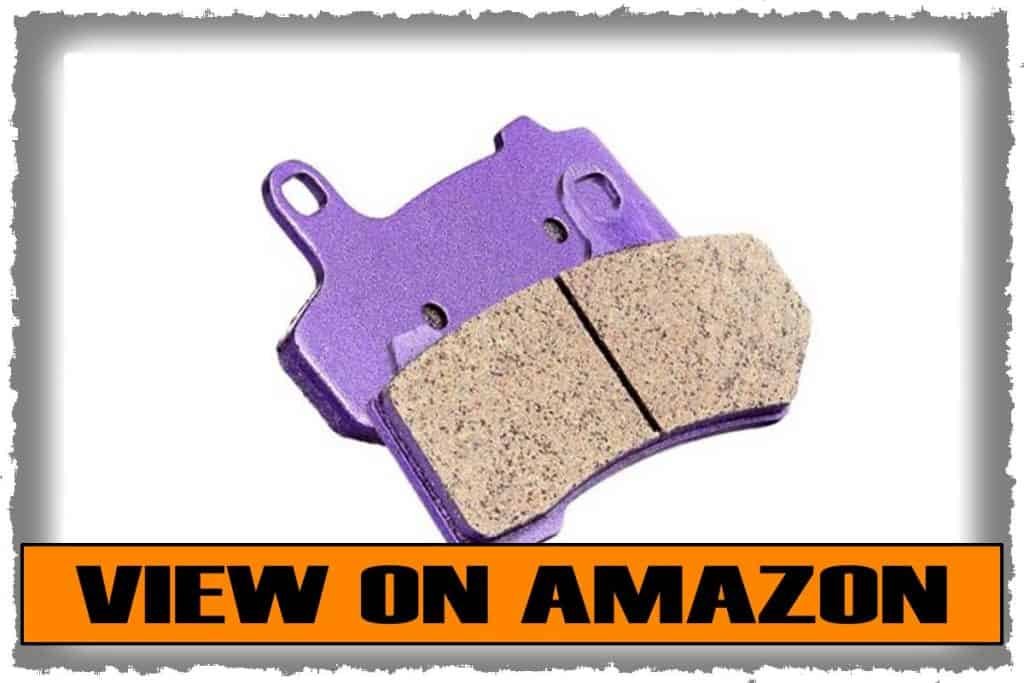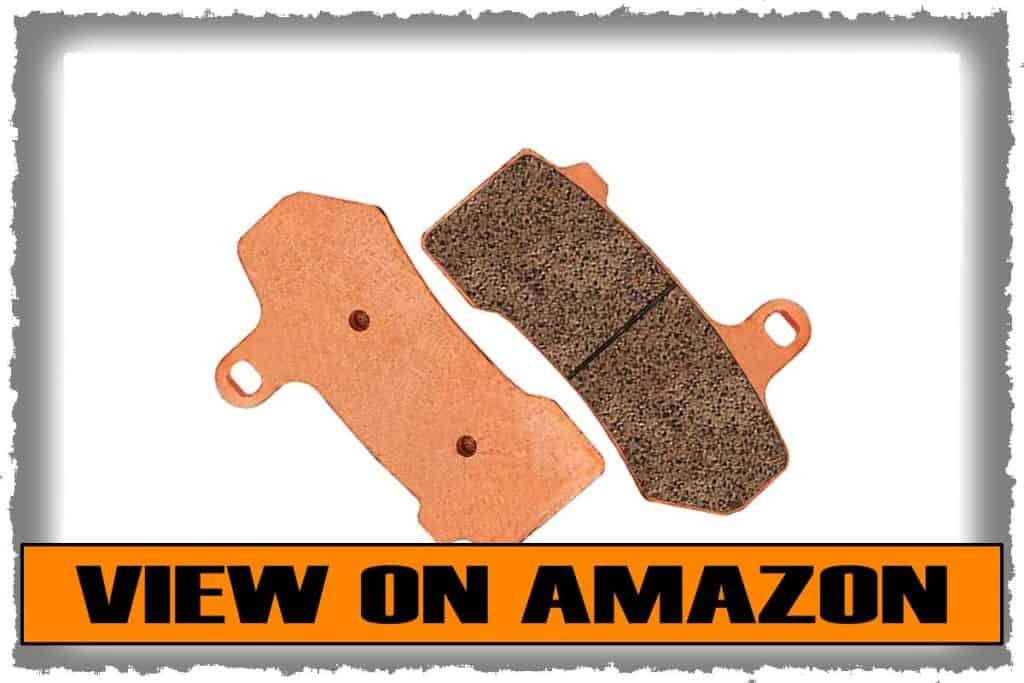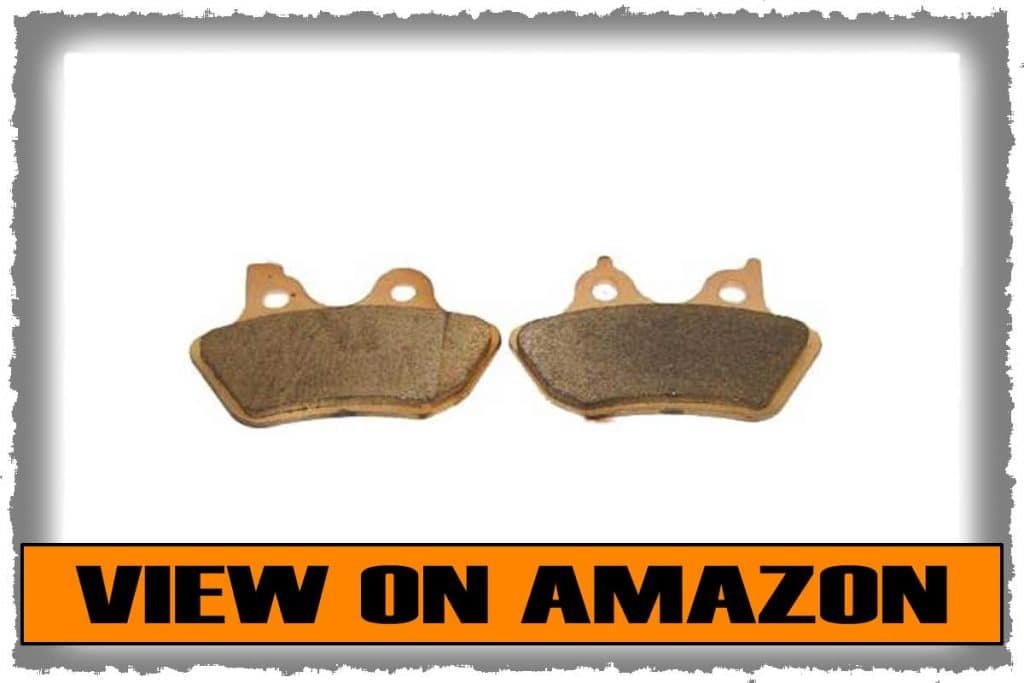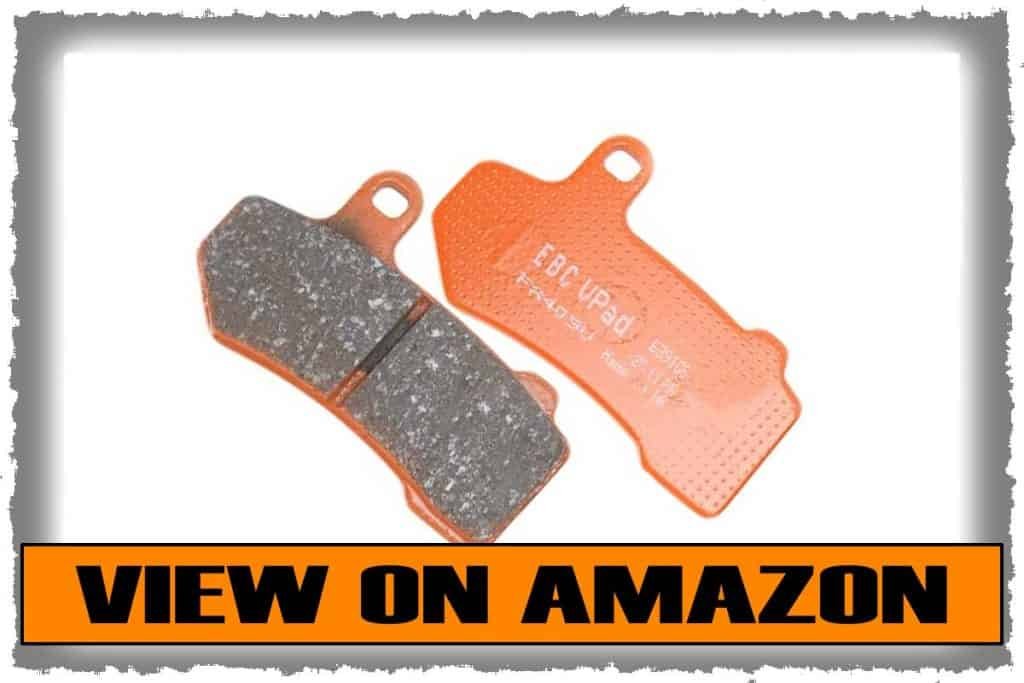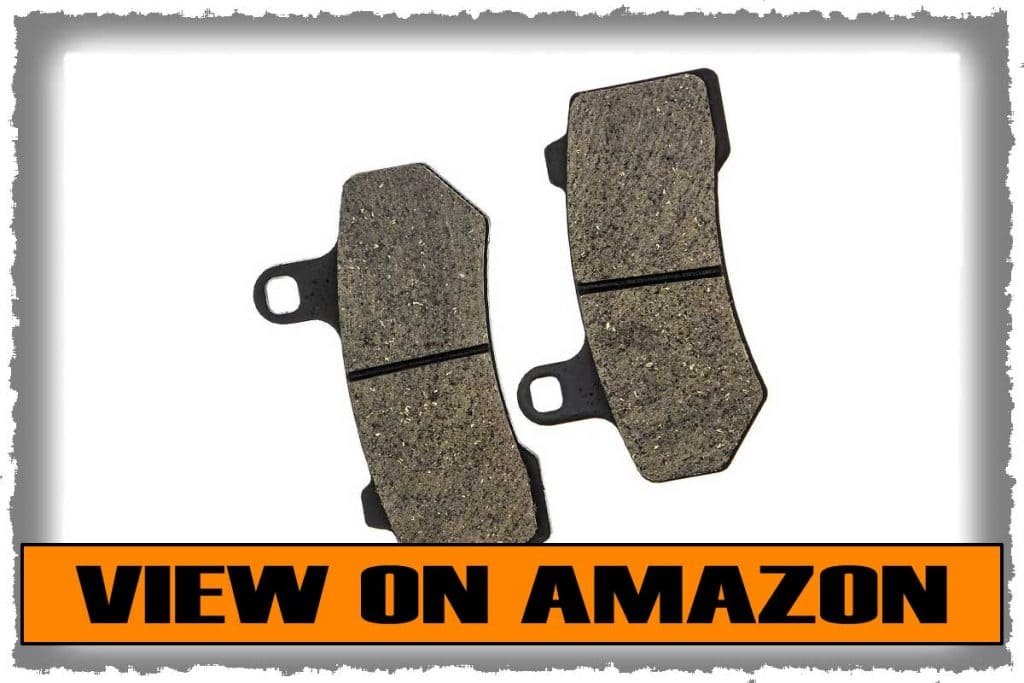Brake pads may not be the most exciting part of your bike, but they certainly are one of the most important. Without one, you are simply tempting fate. They’re a crucial component of any vehicle, including your beloved Harley.
Brake pads generate friction, thus helping your car/motorcycle come to a halt easily. Essentially, brake pads ease your driving experience and help avoid any damages. What will happen if you don’t use brake pads? The braking system would overheat and fail. Nobody wants that to happen!
The table given below entails the main features of various brake pads that are well-suited for Harley Davidson:
| NAME | Material | POSITION | Model Year |
|---|---|---|---|
| ECCPP carbon brake pads | Carbon fiber | Front | 2008-2014 Harley Davidson FLHTCU Ultra Classic Electra Glide |
| Zinger Brake Pads | Ceramic | Front + Rear set | Harley Davidson 2008-2018 FLHTCU Ultra Classic Electra Glide, FLHRC Road King; 2007-2017 VRSC |
| Foreverun Motor | Copper | Rear | Harley Davidson 2000-2007 Touring Electra Glide Ultra Classic |
| EBC Semi-sintered | Ceramic | Front | Harley Davidson FLHTCU Ultra Classic Electra Glide 2008-2013, FLHTCU Ultra Classic Electra Glide 2014-2015, FLHTCUL Ultra Classic Electra Glide Low 2015 |
| NICHE Brake Pads | Alloy steel | Rear | 2014-2019 Harley-Davidson CVO; 2008-2019 Harley-Davidson Road King, Street, Electra Glide |
The right brake pad can majorly impact your driving experience. And finding the perfect brake pad for your Harley-Davidson can be quite tiresome, especially since there are so many options available in the market. So we’ve decided to do you a solid and have compiled a list of some of the best brake pads for Harley-Davidson Touring, along with some necessary information all bike owners should know about brake pads.
Table of Contents
1. ECCPP – Front and Rear Braking Pads Kit for Harley Davidson Touring
If you noticed your brake pads creating annoying noises and all you are looking for are relatively quiet brake pads, the Carbon Fiber Brake Pads ECCPP may be just the thing for you. These brake pads feature a Kevlar carbon fiber compound that has an anti-noise shim and promises to deliver a quiet and smooth braking experience.
With exceptional stopping power, these brake pads make minimum noise and have no rotor galling even if the rotors are polished.
Superior Performance
These Kevlar carbon brake pads feature a combination of high-strength fibers that reinforce the friction material of the brake. This helps enhance the thermal stability and durability while also minimizing abrasion levels on the rotor. They perform better than the standard organic brake pads and certainly rank above the standard semi-metallic pads. The Kevlar fiber keeps the rotors safe from harm and is a better alternative to metallic or semi-metallic pads.
These brake pads deliver amazing fingertip control and a strong enough brake response that can be predicted, regardless of the conditions you are riding through.
Pros:
- Carbon fiber causes no noise.
- Longer life than the usual metallic brakes.
- Assures fingertip brake power.
- Softer on brake discs/rotors.
- Easy to install.
Cons:
- The pads do not have a notch cut because of which the generated gases cannot escape.
- The brake pads do not fit as advertised.
- If you want fading breaks and wish to purchase them at a cheaper price, these are good enough, but not useful if you’re looking for effective results.
- These brakes are extremely noisy, especially when there is a bit of moisture around.
- The brake pads are not that good enough to grip the front wheels of the motorcycle.
Recommended or Not?
If you are looking for brake pads that do not make noise, promise longer durability, are gentle on the brake discs of your bike, and are easy to install, these ECCP Carbon Fiber Brake Pads could be perfect choice.
2. Zinger – Harley Davidson Ceramic Brake Pads
Zinger Brake Pad assures a safe and comfortable ride for motorcycle users and is compatible with the Harley Davidson Touring series. The pack includes 2 front brake Pads and 1 rear brake pad for Harley Davidson along with a changing kit and instruction manual.
Greater Durability
These brake pads are made of Double-H sintered metal and fulfill the OEM quality requirements. This makes them a great choice for rough drives on wet and muddy trails and in extreme weather. Zinger brake pads can also sustain high temperatures, and thus friction caused by sudden braking will not affect them.
Zinger brake pads are thick and create fewer vibrations or noise. They also do not create excessive brake dust. Just like rough roads, these brake pads work perfectly on regular concrete roads as they have a solid grip.
Pros:
- Longevity
- Prolific stopping power
- Brake sensitive
- Durable
Cons:
- Sintered brake pads tend to be noisier.
Recommended or Not?
These brake pads can be your go-to brake pads for your Harley Davidson if you plan on riding on rocky terrain. They are highly durable and have prolific stopping power. But, if you are looking to eliminate noise from your brake pads, then avoid these as-sintered brake pads that are notorious for being noisy. Priced fairly, Zinger brake pads are known to ensure unparalleled performance.
3. Foreverun – Brake Pads for Harley Davidson Street Glide
These affordable metal braking pads by Foreverun Motor could be a great voice for those looking for durability with high performance.
Made of copper and alloy, these sintered brake pads can deliver exceptional performance. Sintered brake pads are known to be highly resistant to fading compared to standard brake pads. The sintered metal brake pads make them very useful in extreme conditions such as mud races and farms.
Ride Through Extreme Conditions
Not only are they able to sustain extreme weather, heat, and friction, they also respond well to sudden braking. This makes them a great choice for riding through muddy, wet roads as well as dry and uneven streets.
They are a great fit for street-cruiser motorcycles. Besides, if you have some experience installing brake pads, installing Foreverun Motor brake pads on your Harley should be quite easy. These brake pads fit nearly as well as the original equipment and are compatible with Harley Davidson Street Cruiser motorcycles.
Pros:
- Handles heat well
- Good for wet weather
- Front and rear calipers can be replaced
- Sintered metal brake pads
- High endurance
Cons:
- Tend to produce a squeaking sound now and then
- Not compatible with the newer models
Recommended or Not?
These brake pads handle the heat generated with absolute ease. They also promise to live up to their reputation of handling your bike well in wet conditions. Made of alloys (brass) the brake pads ensure endurance and durability.
When it comes to winding, hilly terrain, the Foreverun Motor Front and Rear Sintered Brake Pads work magically well.
4. EBC Brakes – Harley Davidson Front Brake Pads
These semi-sintered V-pads by EBC are specially designed to be used for touring or other intense use. If you wish to run your bike through rough and uneven terrain, this could be an option to consider. This model has been specifically designed for the heavy cruiser/ street bike market.
Best of Both Worlds
The V-pad is made of asbestos-free organic material and includes 30% copper. This makes these brake pads the perfect combination of the advantages of an organic pad with the sintered pad’s high durability and performance.
It ensures low heat generation, low dusting, and stable braking. Besides, these brake pads have medium-high friction levels and thus deliver exceptional braking performance regardless of the operating temperature. The rotor and pad wear are also minimal.
The semi-sintered V-pads have been dyno tested and have proven to have a longer life as compared to other cheap brake pads.
Pros:
- Long-wearing
- Less dust on wheels
- High endurance
- Easy to maintain
- Durable
Cons:
- Does not fit certain newer models
Recommended or Not?
If you’re bothered by dusty wheels and brake pads that are short-lived and are too hard to maintain, the EBC Brakes EBPCK2013 Front Semi-Sintered V-Pads would certainly be a good choice.
5. NICHE Brake Pad Set for Harley-Davidson OEM Part Number: 41854-08
Expected to exceed the expectations of an original brake pad by all means. Niche brake pads have been specifically designed to be the perfect direct replacement of factory brake pads.
Smooth Ride
Made of alloy steel, these brake pads have been tested to meet and even surpass the original part’s standards and performance. Not only do these semi-metallic brake pads ensure exceptional stopping when wet in the rain, but they also ensure a smooth ride with a considerably reduced amount of dust.
Easy to install, they’re also fairly priced and deliver great bang for your buck.
Pros:
- Durable
- Smooth braking
- Less dust
- Compatible with a lot of models
Cons:
- Thickness less than OEM
Recommended or Not?
When buying brake pads, people often look for ones that are compatible with a wide range of models. When it comes to compatibility, the NICHE Brake Pad Set stands out. Not only is it compatible but also promises durability. These brake pads are highly suggested.
Buyer’s Guide
Types Brake Pads

There are typically three main types of brake pads: organic brake pads, semi-metallic brake pads, and ceramic brake pads.
Organic
Initially, asbestos was used as the major component to make brake pads because of its longevity and heat resistance. Later when it became known that asbestos dust holds a health threat, an organic version was developed.
Organic brake pads are made of Kevlar, glass, fiber, and rubber. Such brake pads are only of regular use and are not compatible with other terrains. But they do ensure less noise and tend to be the least expensive.
Semi-metallic
Semi-metallic brake pads are more expensive than organic brake pads. They are made of copper, steel, wire, and other similar metallic compounds.
These brake pads are very durable and allow you to ride your bike to hilly areas and in all kinds of weather. But they are much noisier and generate a lot of dust.
Ceramic
Ceramic brake pads are the most expensive in the market but they also come with numerous benefits. Made of ceramic fibers combined with other filler materials, they deliver superb performance.
They are also noise-free, cleaner, and have heat stability. But, they are not ideal for racing.
What To Look For When Buying a Brake Pad
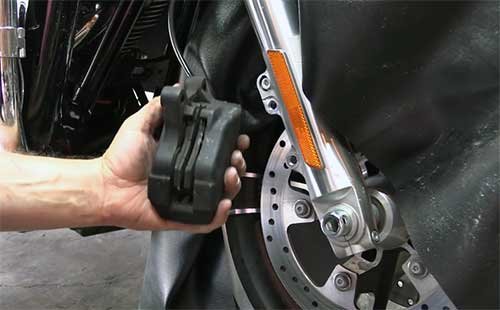
Type or Material
This is probably the first thing you should decide on. The type of brake pad will be based on the material it is made of. As we’ve explored before, brake pads can be sintered, which are metallic, organic, which are non-metallic, or semi-metallic. If you want quiet brake pads, buy organic pads as sintered pads create a lot of noise.
But if you plan on riding your bike in muddy terrain, sintered brake pads will be your best bet as organic pads create too much brake dust.
Type of Bike
Of course, which bike you own is a major determinant of which brake pad you will buy. There is a huge difference between regular bikes and racing bikes and how they function. And thus, hard-wearing brake pads are necessary for racing bikes.
Compatibility
Different brakes need different types of brake pads. For example, some brake pads are more suited to street-cruiser motorcycles while others are best compatible with the touring series bikes.
Make sure you check the manufacturer’s list of the bikes that are compatible with specific pads.
Brake Dust
Based on the brake pad material, some create more brake dust. Make sure you check which models have a lower probability of brake dust.
Type of Rotors
Different types of rotors also impact the brake pad that you will buy. Make sure you know the kind of rotor used in your bike. An incompatible brake pad can lead to some damage to the rotors. Sintered brake pads, for instance, can wear down certain rotors.
Organic brake pads are best suited for rotors that are made of stainless steel or cast iron.
In the case of chrome-plated or aluminum alloy rotors, ceramic brake pads would be best.
Noise
Some brake pads can emit annoyingly loud squeaking sounds, and then there are others that are comparatively quiet. For instance, organic brake pads are very quiet compared to sintered brake pads.
Fade
Heat buildup leads to brake fade, which is more commonly seen in organic brake pads that are made using softer materials. Brake fade makes your bike unable to brake.
So if you think you’ll be driving on long, steep descents, then go for sintered brake pads. These brake pads can tolerate high heat levels and thus are not very likely to have brake fade. They are also better for racing compared to organic brake pads.
Conditions
The conditions in which you will be riding your bike will play a big role in determining which brake pads you will need. Sintered brake pads, for example, will be a better choice for muddy terrains. On the other hand, ceramic brake pads work well in diverse conditions.
FAQs
Regularly inspecting your brake pads is a must. Use a flashlight to check the calipers and the inner and outer pads
If the friction lining looks like it has been excessively worn down (e.g., 1/8 of an inch or less), then you need to replace the brake pads.
Apart from visually inspecting the brake pads, listen to what kind of sounds it’s making. Some squealing sounds are normal but if you hear scraping or grinding, that means the metal rake pad backing has begun rubbing off against the rotor surface. If unattended, this can damage the rotors and may even cause a crash as you won’t be able to stop quickly when needed.
No, it’s not necessary. If you make it a habit to maintain your rotors and use the appropriate brake pads, your first set of rotors can last you for a number of years.
You should change your rotors if they look discolored (typically blue), worn thin, or have deep grooves, or are warped.
Yes. When you fit new brake pads, use cooper grease to apply on the rear surface of the brake pads. This will help reduce the squealing noise that brakes make.
That depends on various factors. For example, aggressive riding will wear out your brake pads faster. Besides, if you use one break more frequently than the other, you will wear it out more quickly. The thickness of the brake pads will also factor into the longevity of your brake pads.
OEM, or original equipment manufacturer, brake pads are custom-made for ensuring compatibility with your bike. They are thus the ideal choice.
However, if you’re looking for better braking performance, then you should probably use a more aggressive brake pad. But you should know that an aggressive brake pad will also negatively affect your rotor and make it wear down more quickly.
For track days, if you’re racing, or are carrying a substantial amount on your bike, aggressive brake pads would be a good choice.
In case your bike has aftermarket rotors, find brake pads made by the manufacturer of the rotor as all rotor types are compatible with specific types of brake pad material.
Conclusion
If you want a hassle-free ride, you need to put in the effort to regularly maintain and invest in your bike. It may seem like a hassle, but it’ll be worth it in the end.
Hopefully, you now have a better idea of the materials used to make brake pads and the benefits that tag along with them. Make the best brake pad choice for your Harley to glide along the open roads!

